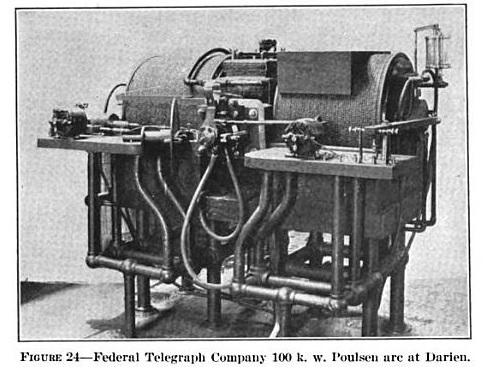 While the final seeds of war were being sown in Europe, in this hemisphere, the Panama Canal was quickly coming to completion, and opened on August 15, 1914. This feature in the Burlington (Vt.) Weekly Free Press for July 30, 1914, shows some of those finishing touches. These included the powerful radio station, which was still under construction:
While the final seeds of war were being sown in Europe, in this hemisphere, the Panama Canal was quickly coming to completion, and opened on August 15, 1914. This feature in the Burlington (Vt.) Weekly Free Press for July 30, 1914, shows some of those finishing touches. These included the powerful radio station, which was still under construction:
Work on the three 600-foot steel towers of the proposed Darien radio station at Caimito has begun and will be completed before opening day. Each tower is built in the form of an equilateral triangle, 150 feet on the side. At each corner of the triangle will be a footing of concrete. The depth of the excavation for the footing has varied from twelve to twenty-eight feet below the surface of the ground, the greater depth being necessitated by the irregular surface elevations, The concrete base will be rectangular in plan, sixteen by twenty, and ten feet deep. The building to serve as quarters for operators has been practically completed and will be provided with furniture by the Navy. New radio stations for relatively local use as compared with long distance stations are to be erected at Colon and Balboa and will supplant the ones now in service at these points. The towers resemble the ones at Arlington, Virginia, and each station will have two three hundred feet towers six hundred feet apart. The present wooden masts at Colon, about two hundred feet high, and the antennae of the present Balboa station are suspended at an elevation of about one hundred and ten feet above the ground between the steel tower and the power plant.
When the station, whose callsign was NBA, became operational, it was able to make regular contact with the powerful navy station at Arlington, Virginia. The transmitter is shown here:

Photo, Google Books
This is a 100 kilowatt Poulsen arc transmitter, manufactured by the Federal Telegraph Company. It is described as being very sturdily designed, with an “unusually rugged and elaborate water-cooling system.” The arc transmitter produced a continuous wave signal, and could even be modulated for voice transmissions (although this one was used strictly for radio telegraph work).
